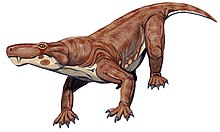| Scylacosauridae Temporal range: Middle Permian–Late Permian, | |
|---|---|
 | |
| Life restoration of Scylacosaurus | |
| Scientific classification | |
| Domain: | Eukaryota |
| Kingdom: | Animalia |
| Phylum: | Chordata |
| Clade: | Synapsida |
| Clade: | Therapsida |
| Clade: | † Therocephalia |
| Clade: | † Scylacosauria |
| Family: | † Scylacosauridae Broom, 1903 |
| Genera [1] | |
| |
| Synonyms | |
Scylacosauridae is an extinct family of therocephalian therapsids. Scylacosaurids lived during the Permian period and were among the most basal therocephalians. [3] The family was named by South African paleontologist Robert Broom in 1903. [4] Scylacosaurids have long snouts and unusual saber-like canine teeth. [5]


